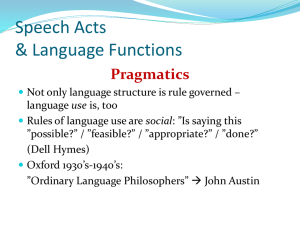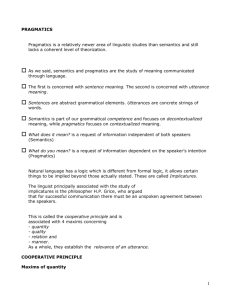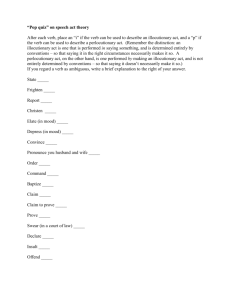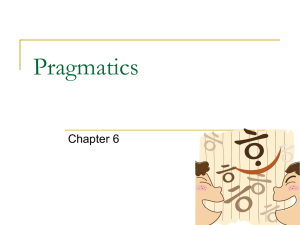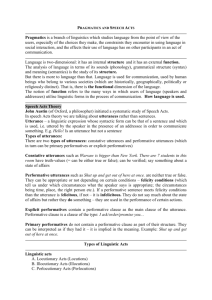overview - Personal Web Pages
advertisement
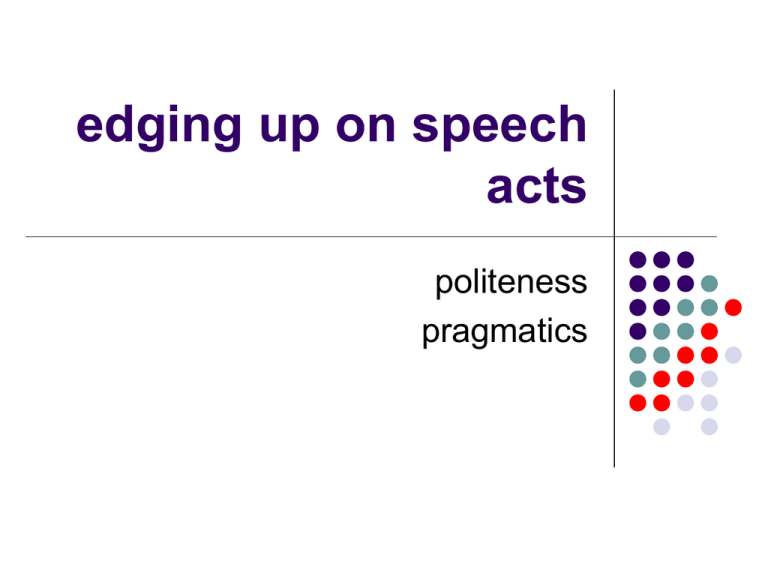
edging up on speech acts politeness pragmatics speech acts: utterance A string of spoken words – you don’t intend to communicate meaning propositional utterance The utterance refers to something else or describes a real or imaginary object. It identifies or specifies. It doesn’t have to intend anything. A blue car Among speakers of English, for example, "It is raining" performs the locutionary act of saying that it is raining, as "Grablistrod zetagflx dapu" would not.. See www.philosophypages.com/dy/l5.htm illocutionary utterance Speaker intends to make contact with the listener, to interact with the receiver Isn’t there a blue car in front of our driveway Example: ‘I’m tired’ http://www.rdillman.com/HFCL/TUTOR/Relation/relate2.html perlocutionary utterances Attempts to affect behavior of the receiver: if Mary’s blue car is blocking the exit, then ‘Isn’t there a blue car in front of our driveway?” (said to Mary) could be perlocutionary http://www.rdillman.com/HFCL/ TUTOR/Relation/relate2.html speech act guess-me 1. You say, "For class tomorrow, please read pages twenty-one through forty-seven." Utterance Propositional Illocutionary Perlocutionary speech act guess-me 2. While talking to a group of friends, you mention that you recently went to hear your favorite band play at a local club. Utterance Propositional Illocutionary Perlocutionary speech act guess-me 3. You and a friend are talking about a television show that you both watched the night before. You say, "What did you think about Tony's reaction to Carmela's news?" Utterance Propositional Illocutionary Perlocutionary speech act guess-me 4. When you discover that the grade you got on your paper is an A, you let out a sigh of relief . Utterance Propositional Illocutionary Perlocutionary speech act guess-me 5. For the last hour you have been riding along with your parents as they look at houses that they might want to buy, and they have not said much to you recently. As the car passes through a neighborhood with a house that has a "For Sale" sign out front, you exclaim, "Oh! There's a nice house." Utterance Propositional Illocutionary Perlocutionary speech act guess-me 6. While sitting on a dock that sticks out into the ocean, you see a dolphin. It surfaces nearby and makes a series of high-pitched sounds: "Chweee,chweee, chweee." Utterance Propositional Illocutionary Perlocutionary Theoretical highlights Austin: Speech Acts (Illocutionary Acts) Bourdieu The linkages of these acts with institutions Grice:The Cooperative Principle and Conversational Maxims Goffman: Facework Activities involved in the presentation of self Brown and Levinson: Politeness (positive and negative face) Helps explain implicature and variation Types of strategies for interaction. Leads to reaction from specialists in cultures, media: for example, http://www.ekl.oulu.fi/MAILL/docs/finsse3.pdf Scollon and Scollon: independence & involvement www.msu.edu/course/anp/420/dwyer/14%20Pragmatics.ppt Linguistic politeness research group http://www.lboro.ac.uk/de partments/ea/politeness/ Sponsored by a little about JL Austin, 1911-1960 Oxford professor of philosophy. In "A Plea for Excuses" (1956), Austin explained and illustrated his method of approaching philosophical issues by first patiently analyzing the subtleties of ordinary language. In How to Do Things with Words (1961), the transcription of Austin's James lectures at Harvard, application of this method distinguishes between what we say, what we mean when we say it, and what we accomplish by saying it, or between speech acts involving locution, illocution (or "performative utterance"), and perlocution. http://www.philosophypages.com/ph/aust.htm J. L. Austin on Performatives – doing something by saying something The uttering of the words is .. the performance of that which is also the object of the utterance. Circumstances around the performative must be appropriate 1. 2. 1. 2. 3. 4. 5. 6. 7. 3. 4. good faith v. bad faith Other things have to go right (happy) (felicities) Must be an accepted conventional procedure Particular persons must be appropriate for the invocation of act Procedure must be executed correctly and completely Person must have those thoughts and feelings requisite of the act Must actually conduct themselves subsequently. Explicit (I bet, I promise, ...) v Implicit performatives (where the performative is only a possibility (might, perhaps, (you might be wrong) Entails (all men blush) v. Implies v Presupposes (all Jack’s children are bald presupposes that Jack has children. Watch that implicature a little about Bourdieu, 1930-2002 ‘Bourdieu, who loved intellectual combat, called himself "to the left of the left"--that is, to the left of the ossified French left-wing parties and also to the left of the academic postmodernists aka antifoundationalists, about whose indifference to empirical work he was scathing. Reading him could be a disturbing experience, because the explanatory sweep of his key concept of habitus-the formation and expression of self around an internalized and usually accurate sense of social destiny--tends to make ameliorative projects seem rather silly’ THE NATION February 18, 2002 issue Pierre Bourdieu, 19302002 by Katha Pollitt Pollitt adds a little more (you might want to look for implicature, she implied) “Take, for example, his attack on the notion that making high culture readily available--in free museums and local performances--is all that is necessary to bring it to the masses. … there is nothing automatic or natural about the ability to "appreciate"--curious word--a Rothko or even a Van Gogh: You have to know a lot about painting, you have to feel comfortable in museums and you have to have what Bourdieu saw as the educated bourgeois orientation, which rests on leisure, money and unselfconscious social privilege and expresses itself as the enjoyment of the speculative, the distanced, the non-useful. Typically, though, Bourdieu used this discouraging insight to call for more, not less, effort to make culture genuinely accessible to all: Schools could help give working-class kids the cultural capital--another key Bourdieusian concept--that middle-class kids get from their families. One could extend that insight to the American context and argue that depriving working-class kids of the "frills"--art, music, trips--in the name of "the basics" is not just stingy or philistine, it's a way of maintaining class privilege” Bourdieu and Speech Acts: conditions of the performative are all associated with the institution 1. 2. 3. Roles: 1. Particular persons must be appropriate for the invocation of the act Practices: 1. Must be an accepted conventional procedure 2. Must be executed correctly and completely Other Considerations 1. Sincerity: Person must have those thoughts and feelings requisite of the act 2. Consistency: Must actually conduct themselves subsequently. Think Donald Trump’s ‘You’re fired’ Following is adapted from www.msu.edu/course/anp/420/dwyer/14%20Pragmatics.ppt a little bit about Grice Herbert Paul Grice was born in 1913 and died in 1988. From the late 1930's until 1967 he held positions at Oxford University. During the war years he served in the Royal Navy. In 1967 he moved to the University of California, Berkeley. He retired in 1979 but continued to teach until 1986. Grice is best known for his analysis of speaker's meaning, his conception of conversational implicature, and his project of intention-based semantics. Largely as a result of these ideas, the focus of the philosophical debate over the nature of meaning shifted during the 1970's and 1980's from linguistic representation to mental representation From the Philosophy of Mind online dictionary/encyclopedia A: How is C getting on in his new job at the bank? B: Oh quite well, I think; he likes his colleagues, and he hasn’t been to prison yet. What is the implicature?While A hasn’t been to prison, he is the sort of person who could easily end up there. The Cooperative Principle and the Maxims The CP Make your conversational contribution such as is required, at the stage at which it occurs, by the accepted purpose or direction of the talk exchange in which you are engaged. Specific Maxims Quality: make contribution 1) as informative and 2) not more informative than required. Quality: don’t say 1) what you believe to be false and 2) that for which you lack adequate evidence. Relation: Be relevant Manner: 1) avoid obscurity; 2) avoid ambiguity; 3) be brief; 4) be orderly. Others? Aesthetic, social, or moral, be polite, ... Cultural Differences: What is relevant, polite, true will vary from culture to culture. Example where no maxims are violated Buying gas A: I am out of gas. B: There is a station around the corner. B would be infringing the maxim of “be relevant” unless he thinks that A can buy gas at the station. Jail example: presumption that connection between implication and prison statement is obvious. Smith’s recent trips A: Smith doesn’t seem to have a girlfriend these days. B: He has been paying a lot of visits to New York lately. In this example the speaker implicates that which he must be assumed to believe in order to preserve the assumption that he is observing the maxim of relation. www.msu.edu/course/anp/420/dwyer/14%20Pragmatics.ppt conflict between Maxims An example in which a maxim is violated, but its violation is to be explained by the supposition of a clash with another maxim. A: Where does C live? B: Somewhere in south Charlotte. B is being vague (violating maximum of quality by saying less) because to be more informative he would have to say something he does not know, thus violating the maxim of quality. Flouting Maxims Examples that involve exploitation: Letter of recommendation: Dear Sir, Mr X’s command of English is excellent, and his attendance at tutorials has been regular. Yours, etc. President: “I never had sex with that woman.” Flouting allows one to say things through implicature without actually saying it (without directly lying). The implicature is not carried by what is said, but only by the saying of what is said, or by ‘putting it that way.” The Universality of the Cooperative Principle and Maxims – or not Grice assumes the the CP and the maxims are universal While universal they may not act in the same way. Different background knowledge. Different ways of resolving conflicts or flouting “Do you really think I look nice in this outfit?” Explain breakdowns in cross-cultural communication. The utility of these maxims in ordinary conversation. a little about Goffman ….The Presentation of Self in Everyday Life, 1959 which is available in at least ten different languages …has been almost continuously in print. … Erving Goffman's primary methodology was ethnographic study, observation and participation rather than statistical data gathering, and his theories provided an ironic insight into routine social actions. For example, The Presentation of Self in Everyday Life uses the theatrical stage as a metaphor to explain how we "stage manage" the images we try to convey to those around us. For this impression management, Goffman coined the term "dramaturgy." (Diane Blackwood: http://www.blackwood.org/Erving.htm) You might want to reference Kenneth Burke here, and also Dell Hymes (more about S-P-E-A-K-Ihttp://therapy.massey.ac.nz/diplomademo/175775/175_775_Dra maturgy.htm Erving Goffman: On Face-Work: An analysis of Ritual Social Interaction The concept of face: The presentation of the self to the other, positive or negative Basic structural feature of social interaction. Rule of self respect: Rule of considerateness: person must go to certain lengths to save the feelings and the face of others present. The Face-Threatening Act. One is expected to maintain face Something that does damage to one’s face. Face Work: Maintaining face; correcting damage The Corrective Process When an attempt is made to re-establish a satisfactory ritual state for persons who have achieved social disequilibrium. Ritual aspect: one’s face is a sacred thing. Stages - Acknowledgement: Begins with acknowledging the threat to face. (The interchange: seems to be a basic concrete unit of social activity.) The challenge: participants call attention to the misconduct The offering: whereby a participant, typically the offender, is given a chance to correct for the offence and re-establish the expressive order. explain as a meaningless act, a joke, unintentional, a mistake, unavoidable, not acting himself, under the influence of something or somebody The acceptance (or not) by the offended of offering Gratitude by the offender (ritual equilibrium re-established) Think televised apologies Politeness: Brown and Levinson Theory, first developed in late 1970s, is based on Goffman’s concept of face Face: The public self-image that every member wants to claim for himself. A communication (speech act) may contain an imposition on the “face” of the Hearer. Language Universals extend beyond the confines of grammar. Both are currently affiliated with Max Planck Institute for Psycholinguistics Instant background http://www.ic.arizona.edu/~comm300/mary/interpersonal/politeness/ Two types of face: Positive and Negative Note: Negative doesn’t mean ‘bad’ Positive Face: Honor The public self. The positive consistent selfimage or ‘personality’ (crucially including the desire that this self-image be appreciated and approved of) by interactants. the want of every member that her wants be desirable to at least some others. Negative Face: Privacy Invented by Brown and Levinson The concept of the right to privacy. The basic claim to territories, personal preserves, rights to non-distraction the want of every ‘competent adult member’ that her actions be unimpeded by others. Kinds of face threatened S threatens H’s Negative Face [imposition] Those that put pressure on H to act: Orders and Requests; Suggestions and Advice; Remindings; Threats and warnings. Those that put H in debt (offers, promises) Those that expression desire or envy of H’s possessions which lead H to think that he has to protect them (complements, envy, expressions of strong emotion (hatred, anger, lust)) S threatens H’s Positive face negative evaluation: disapproval(criticism); disagreement indifference to H’s positive face: violent emotions (reason to fear S); irreverence; bad news about H (good news about S); raising divisive topics (politics); noncooperation; wrong terms of address Threats to H’s face v. threats to S’s Those that offend S’s negative Face S expressing thanks, S acceptance of H’s thanks; S’s excuses; S acceptance of offers; S’s response to H’s faux pas; unwilling promises and offers Those that damage S’s positive face apologies; acceptance of a complement; breakdown of physical control, selfhumiliation, confessions, emotional leakage Strategies for doing FTAs On Record (directly Communicating the FTA directly and unequivocally (I promise to ...) Without redressive action, baldly With redressive action Positive politeness Redress: action that gives Oriented toward the positive face of H [honor] face to addressee by attempting to counteracting the potential face damage of the FTE Negative politeness Oriented toward redressing the negative face [privacy] Off Record (indirect): This strategy: involves some ambiguity so that H is not obligated to respond (Rats, I’m out of cash --cf. Grice on speech acts). Don’t do the FTA Efforts to adapt ‘face’ theory Currently many researchers use frames and strategies of involvement and strategies of independence developed by Scollon & Scollon to handle cross-cultural communications. Their approach incorporates concepts of distance, power and hierarchy, to defuse the ‘negative—bad’ association D = Social Distance between S and H for the purposes of that act and as determined by such things as the frequency of interaction and the kinds of material and nonmaterial goods exchanged.... P = Power-- differential Degree to which H can impose his own plans and own face at the expense of S’s plans and face.
